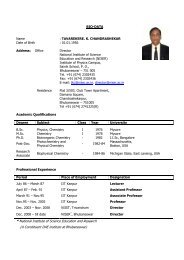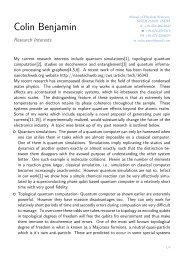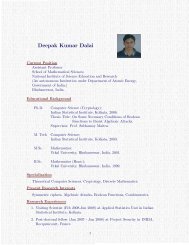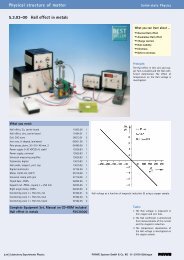Lecture-Notes (Thermodynamics) - niser
Lecture-Notes (Thermodynamics) - niser
Lecture-Notes (Thermodynamics) - niser
You also want an ePaper? Increase the reach of your titles
YUMPU automatically turns print PDFs into web optimized ePapers that Google loves.
4.4. TEMPERATURE AS INTEGRATING FACTOR 31<br />
Proof. Let us divide the cycle P into n segments so that on each segment<br />
its temperature Ti (i = 1, . . .,n) is constant. We consider now a reservoir<br />
at temperature T0 > Ti(∀i) (Fig. 4.7) and introduce Carnot engines<br />
between the reservoir at T0 and Ti.<br />
Figure 4.7: Cycle P connected to the reservoir at T0 via Carnot engines.<br />
For each Carnot engine,<br />
Wi + Q (0)<br />
i + QC i<br />
For cycle P,<br />
with<br />
Q (0)<br />
i<br />
T0<br />
+ QC i<br />
Ti<br />
= 0 (first law of thermodynamics) and<br />
= 0 (definition of absolute temperature).<br />
W +<br />
n<br />
Qi = 0 (first law of thermodynamics),<br />
i=1<br />
Qi = −Q C i .<br />
Then, the total heat absorbed from the reservoir at T0 is<br />
n<br />
n Q<br />
= −T0<br />
C i<br />
= T0<br />
Q (0)<br />
T =<br />
i=1<br />
Q (0)<br />
i<br />
and the work performed by the system is<br />
<br />
n<br />
WT = − W +<br />
=<br />
n<br />
Qi +<br />
i=1<br />
i=1<br />
n<br />
i=1<br />
Wi<br />
<br />
i=1<br />
Ti<br />
<br />
Q (0)<br />
<br />
i − Qi =<br />
n<br />
i=1<br />
n<br />
i=1<br />
Q (0)<br />
i<br />
Qi<br />
Ti<br />
= Q(0)<br />
T .







